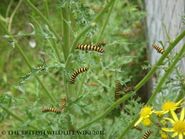
The Cinnabar Moth (Tyria jacobaeae) is a brightly coloured moth, found in Europe and western and central Asia. The moth is named after the red mineral cinnabar because of the red patches on its predominantly black wings. Cinnabar moths are about 20mm long and have a wingspan of 32-42 mm (1.3-1.7 in).
Cinnabar moths are day-flying insects. Like many other brightly coloured moths, it is unpalatable; The larvae use members of the genus Senecio as foodplants. Many members of the genus have been recorded as foodplants but for long term population success the presence of the larger species such as ragwort is needed. Smaller plant species such as groundsel are sometimes used but since the species lays its eggs in large batches survival tends to be reduced. The larvae absorb bitter tasting alkaloid substances from the foodplants, and assimilate them, becoming unpalatable themselves. The bright colours of both the larvae and the moths act as a warning sign so that they are seldom eaten by predators.
Cinnabar caterpillars can turn cannibalistic. This can be due to lack of food, but they can eat other Cinnabar larvae for no apparent reason. Females lay up to 300 eggs, usually in clusters of 30 to 60. Initially the larvae are pale yellow but later larval stages develop the jet black and orange/yellow striped colouring . They feed ravenously and can grow up to 30mm. Cinnabar caterpillars are voracious eaters and large populations can strip entire patches of ragwort clean, a result of their low predation.
Very few often survive to the pupae stage mainly due to them completely consuming the food source before reaching maturity, this could be a possible explanation for their tendency to engage in seemingly random cannibalistic behaviour, as many will die from starvation.

When the Cinnabar is active





